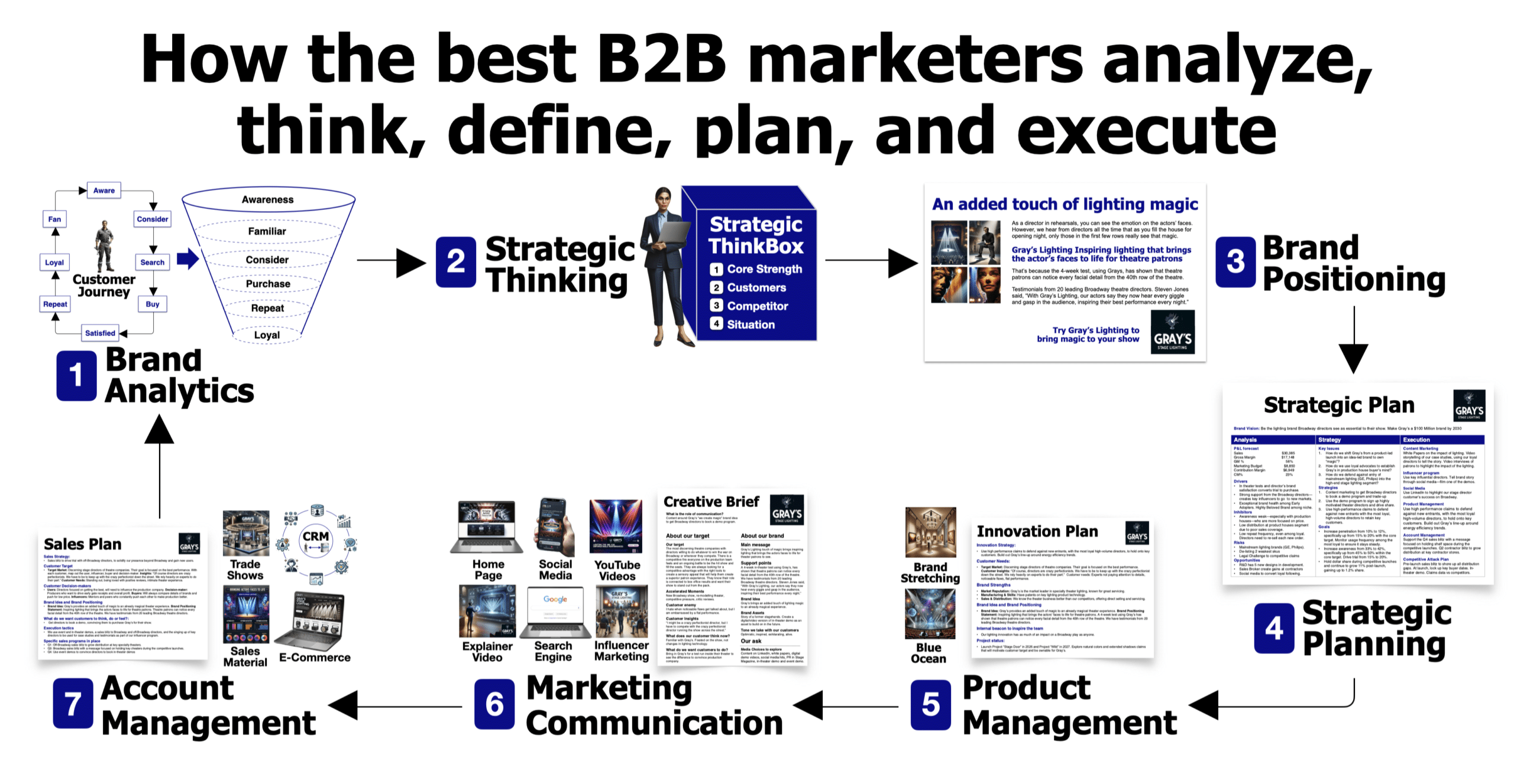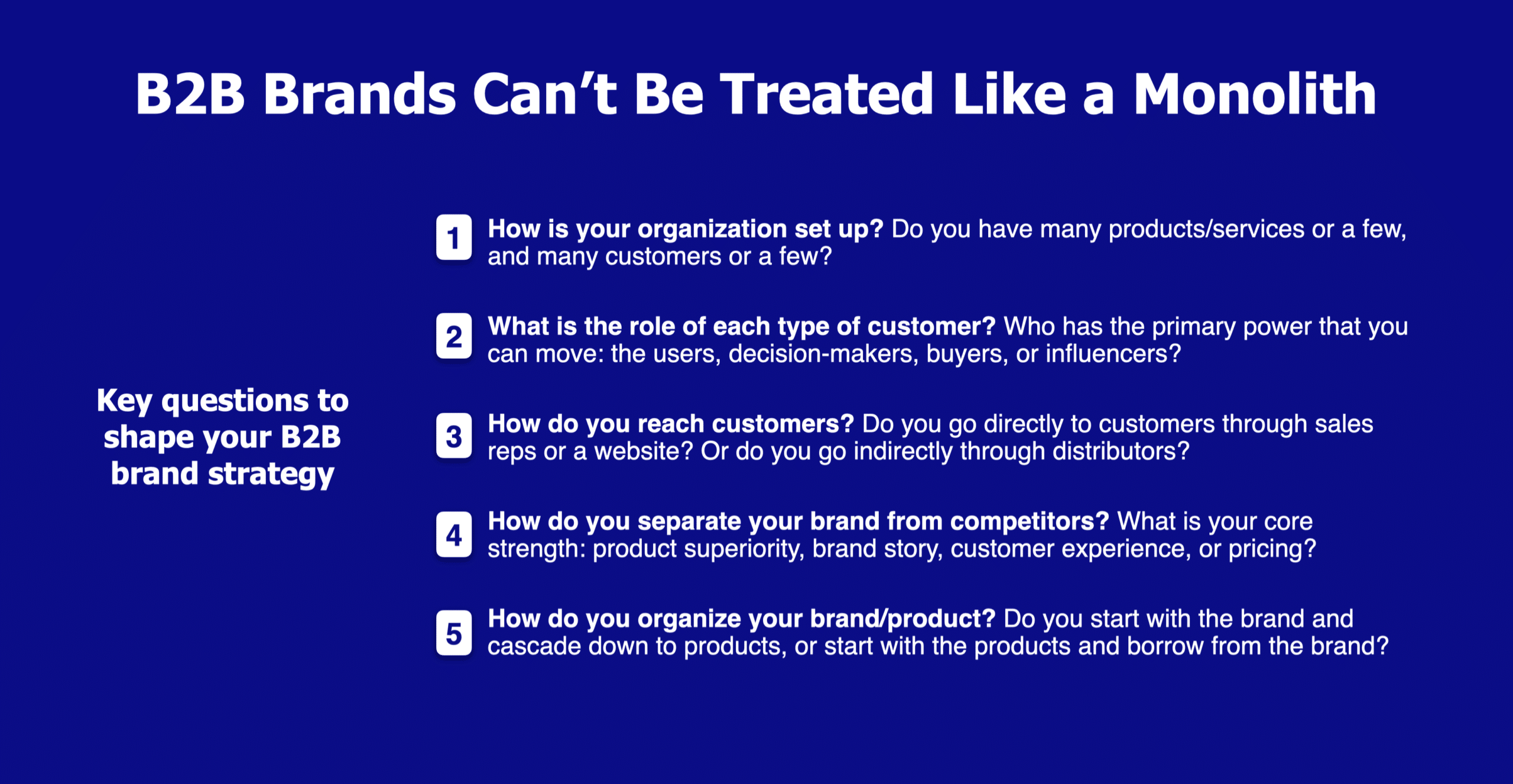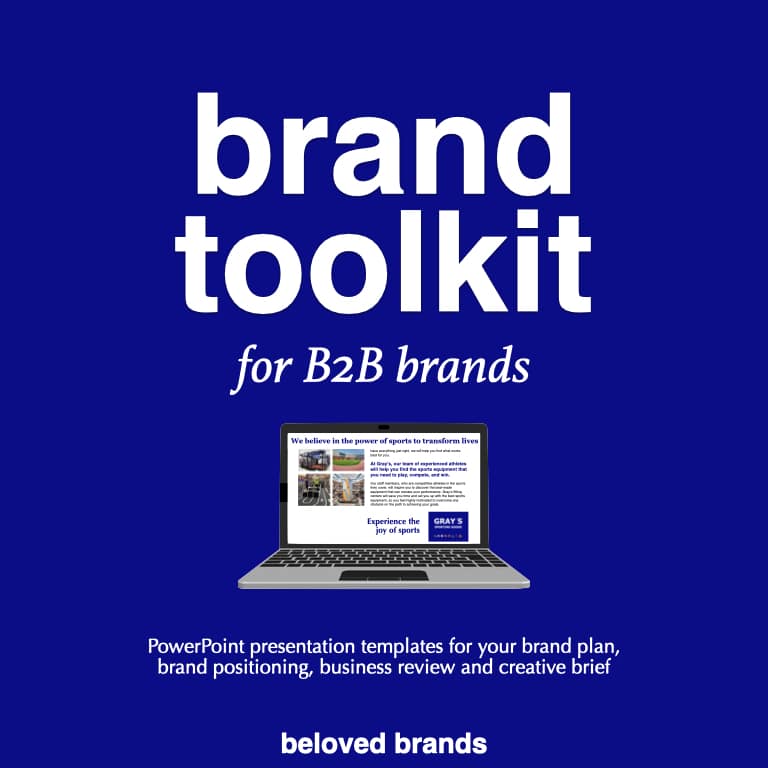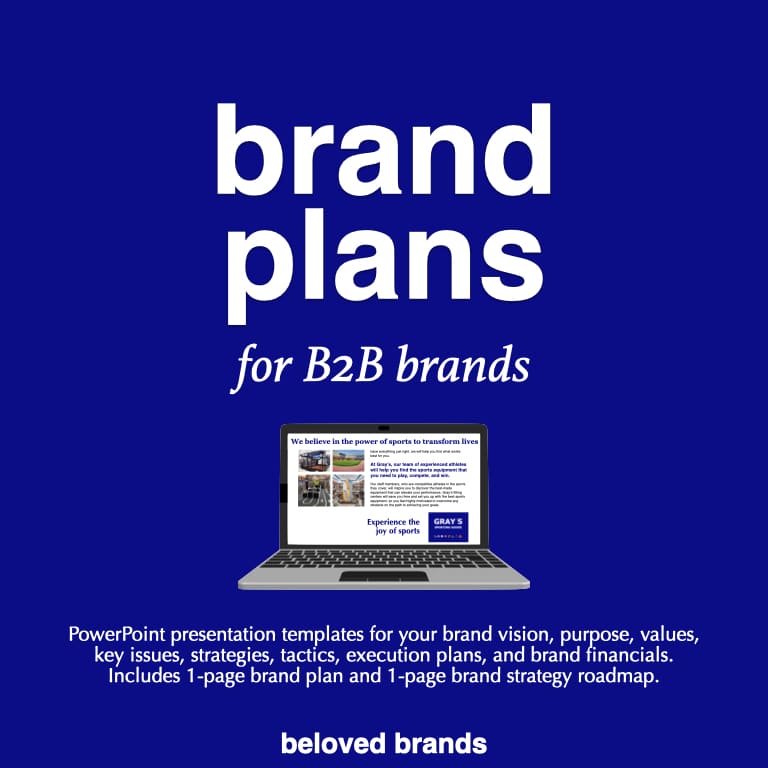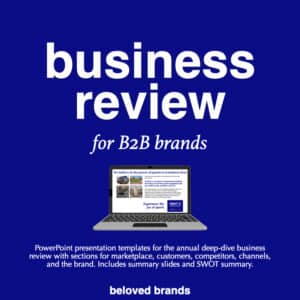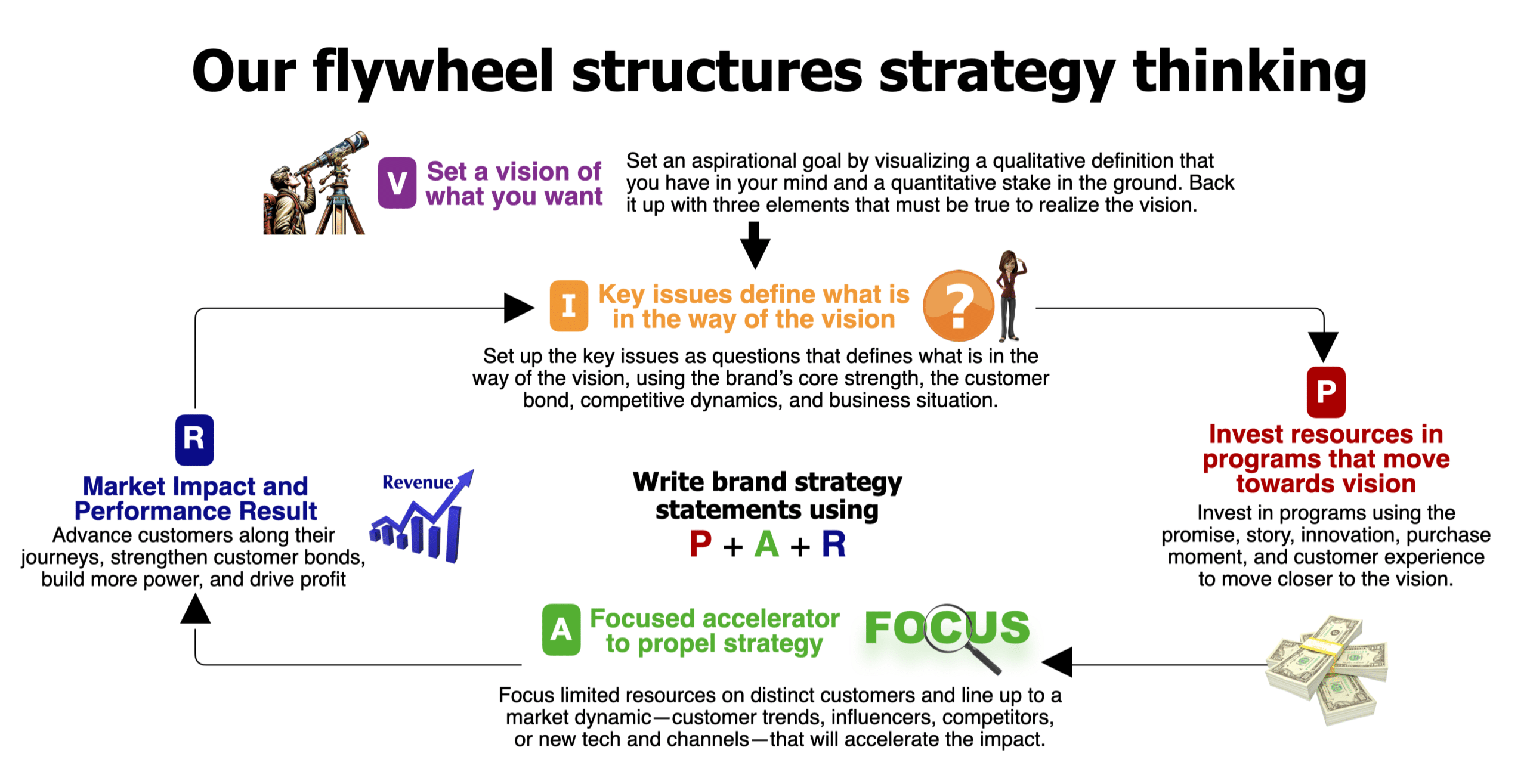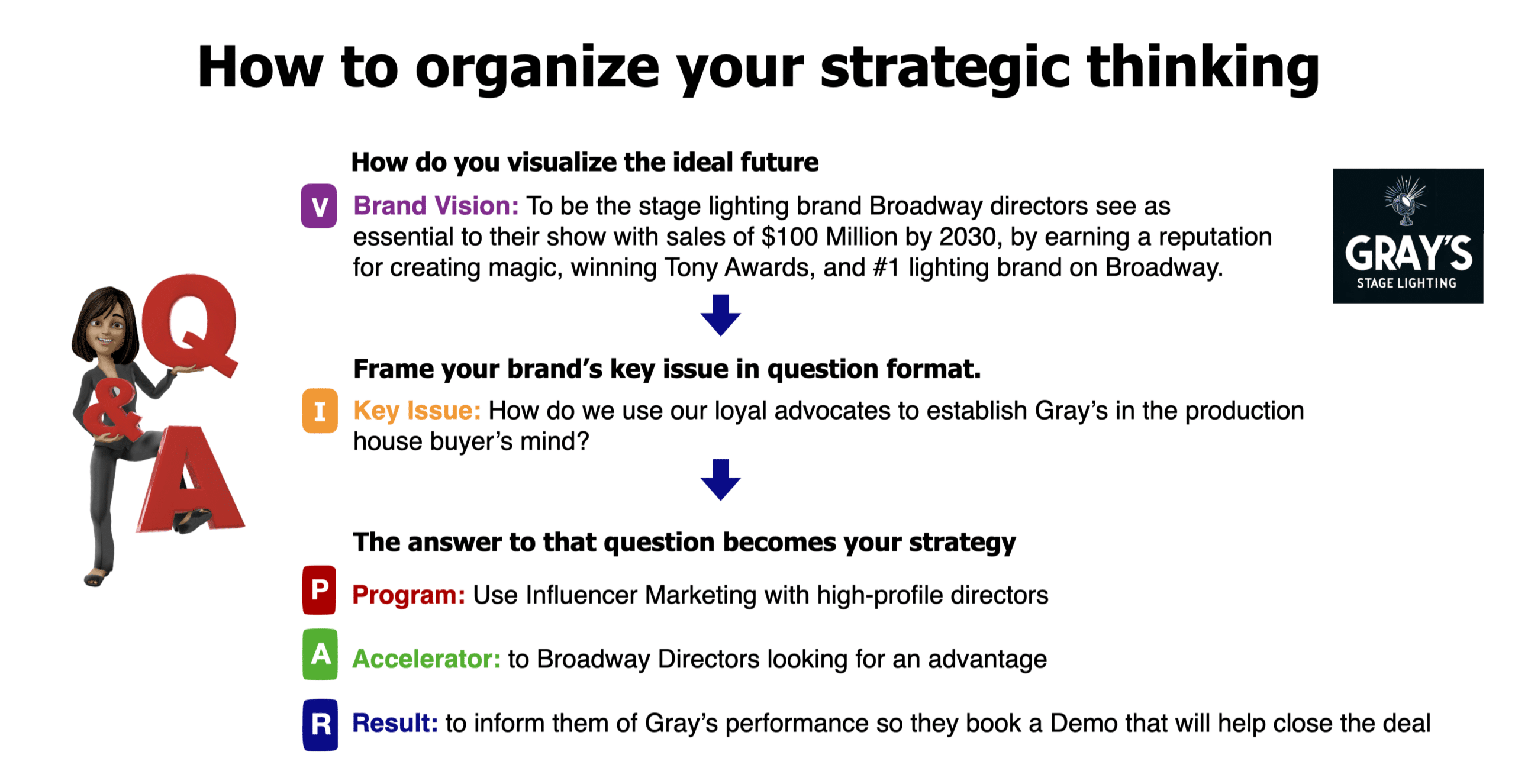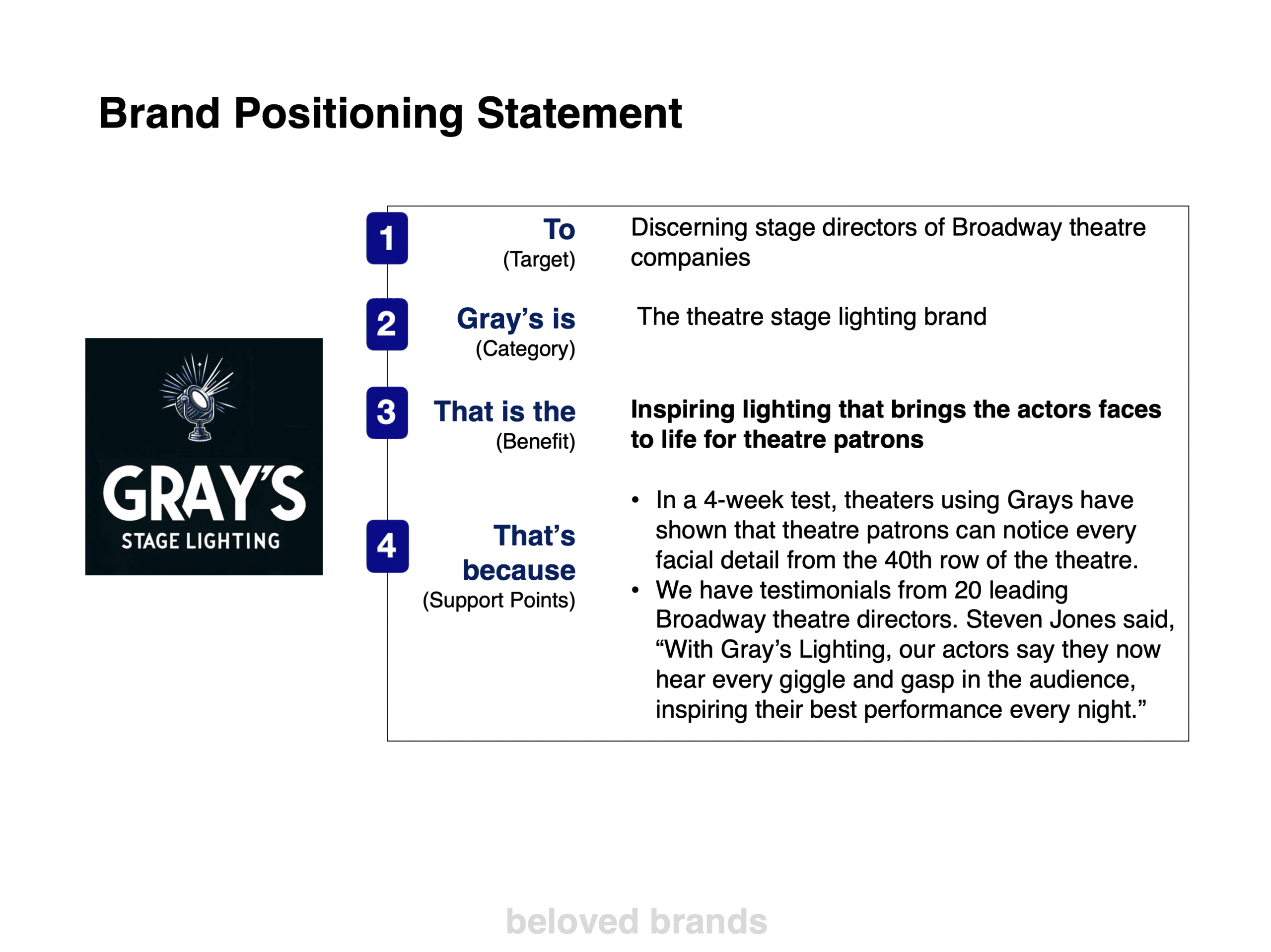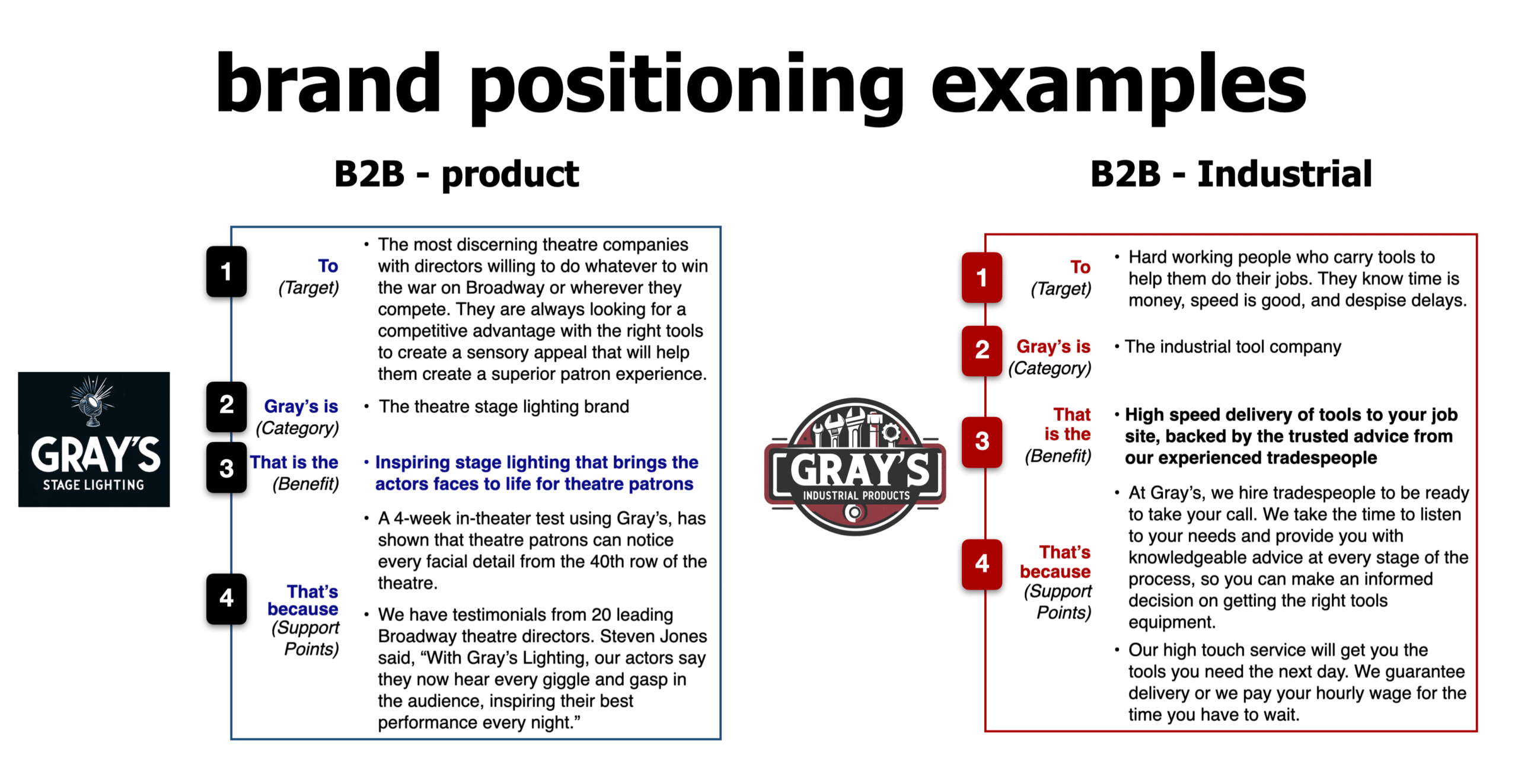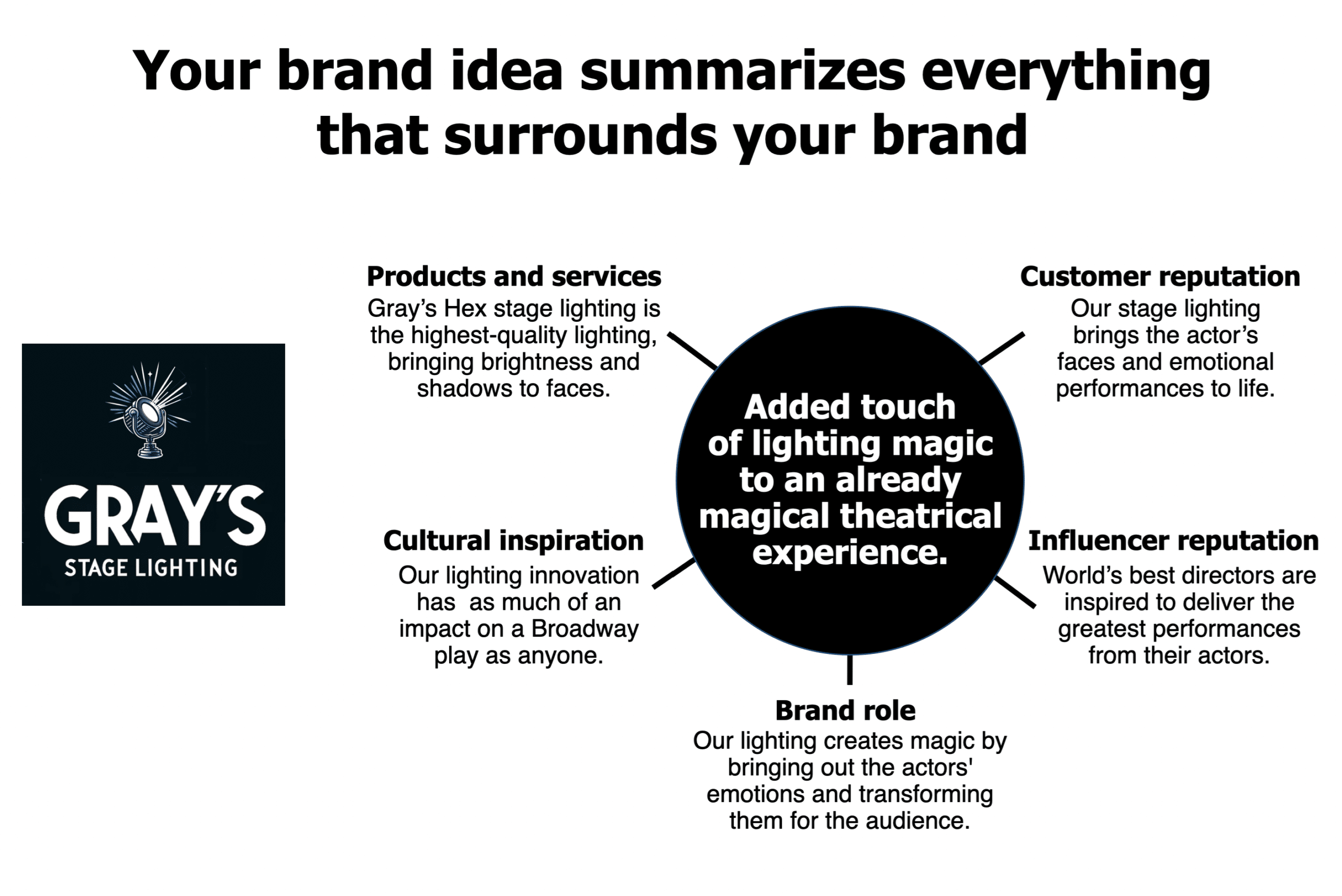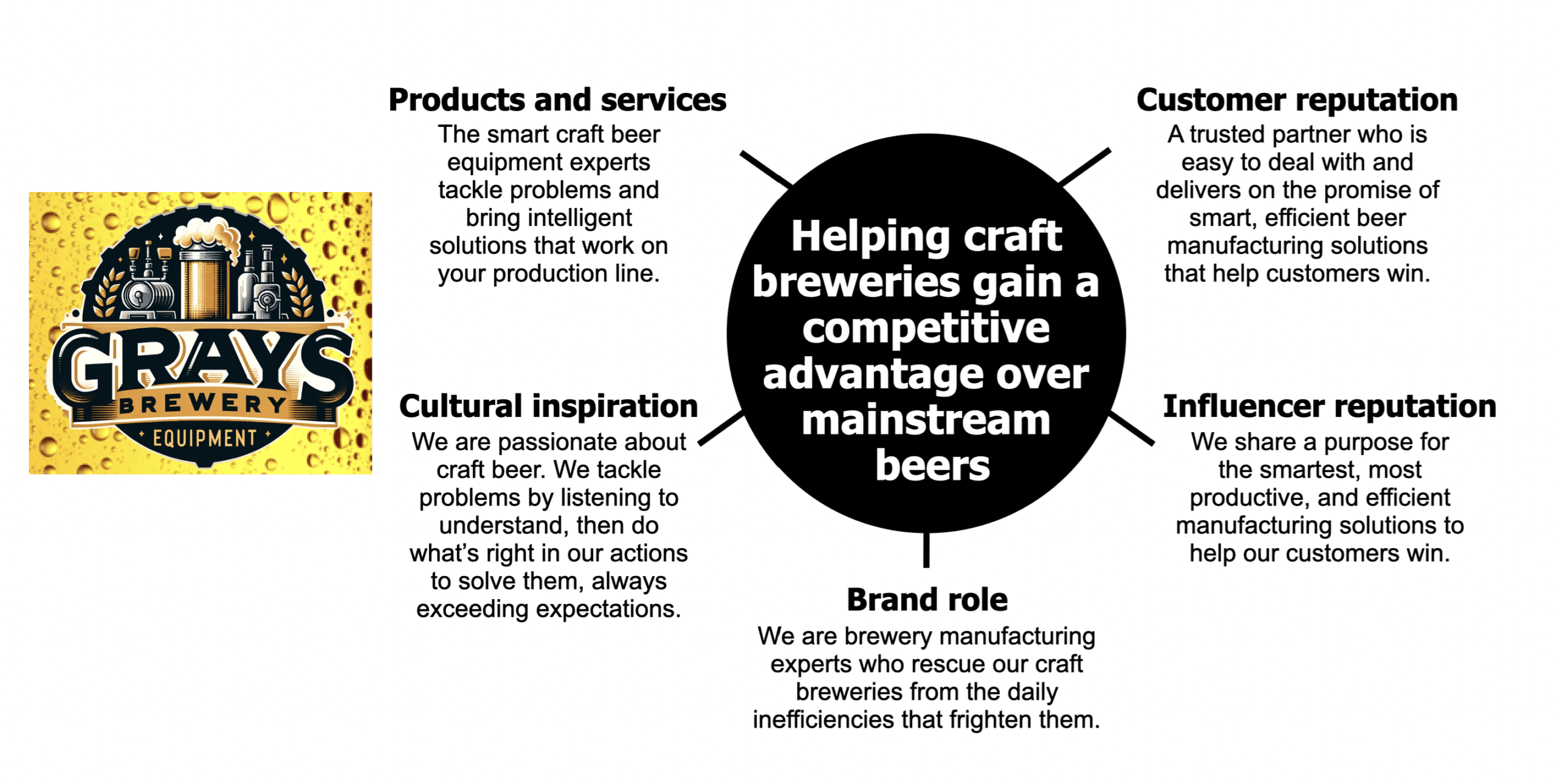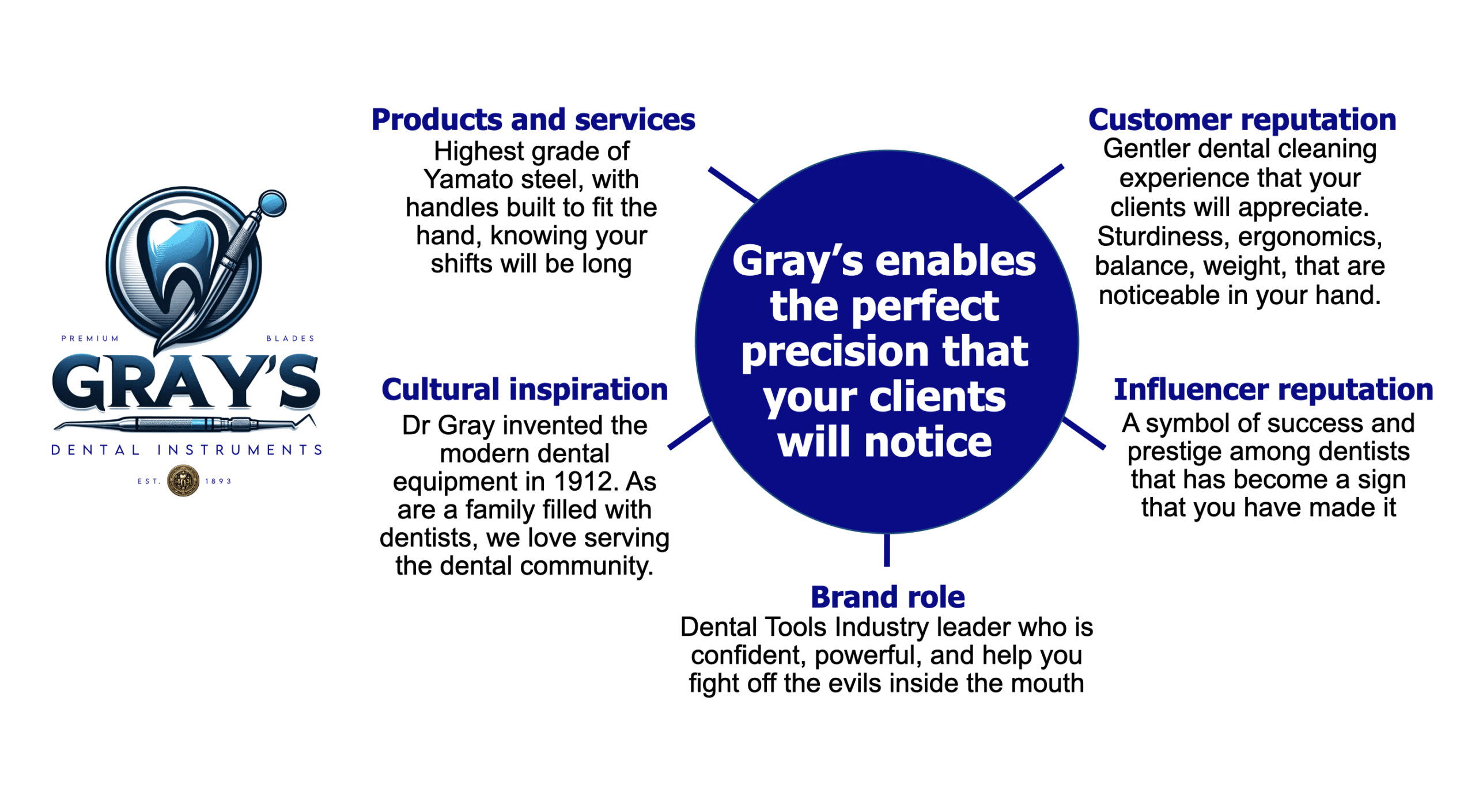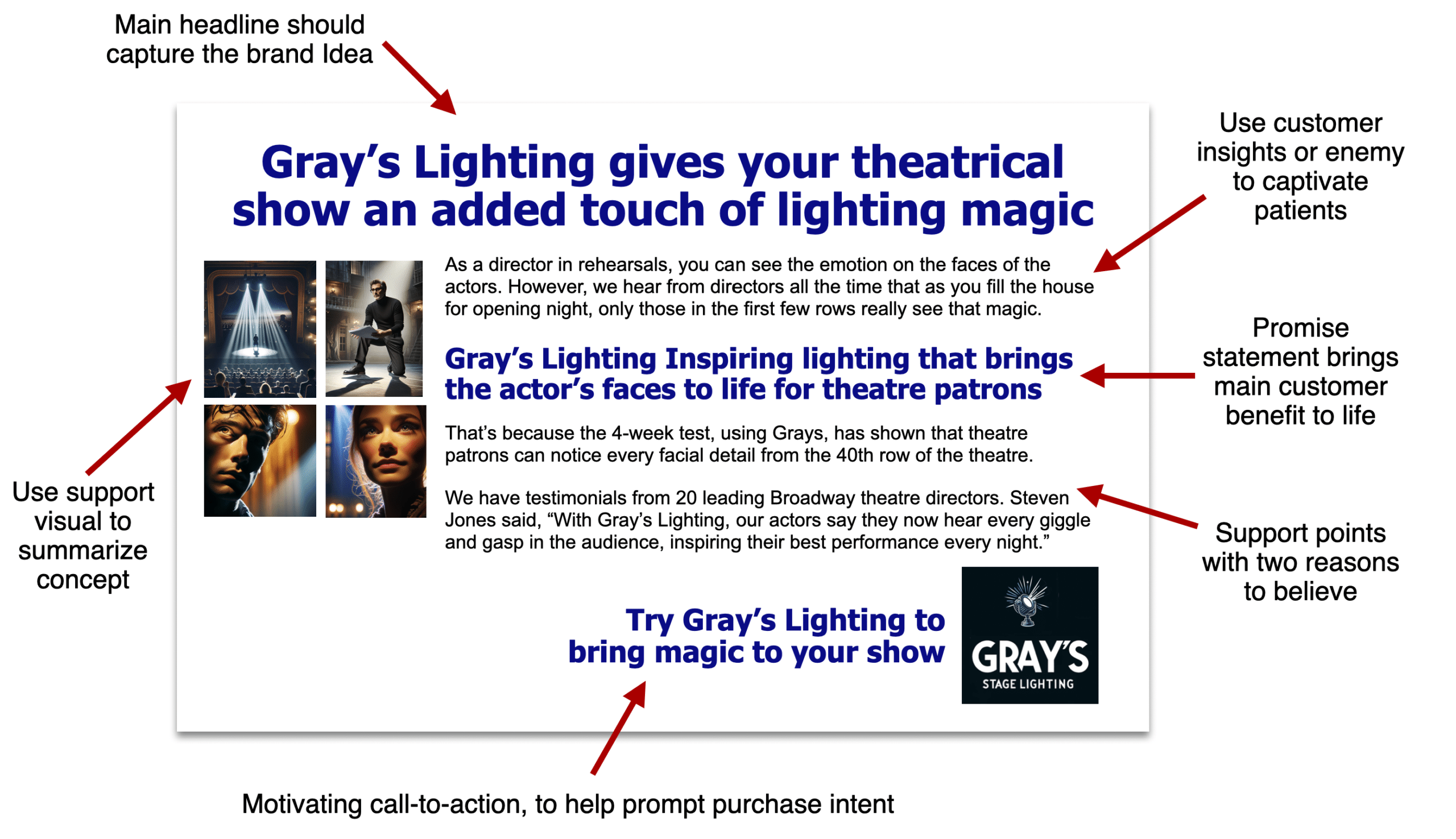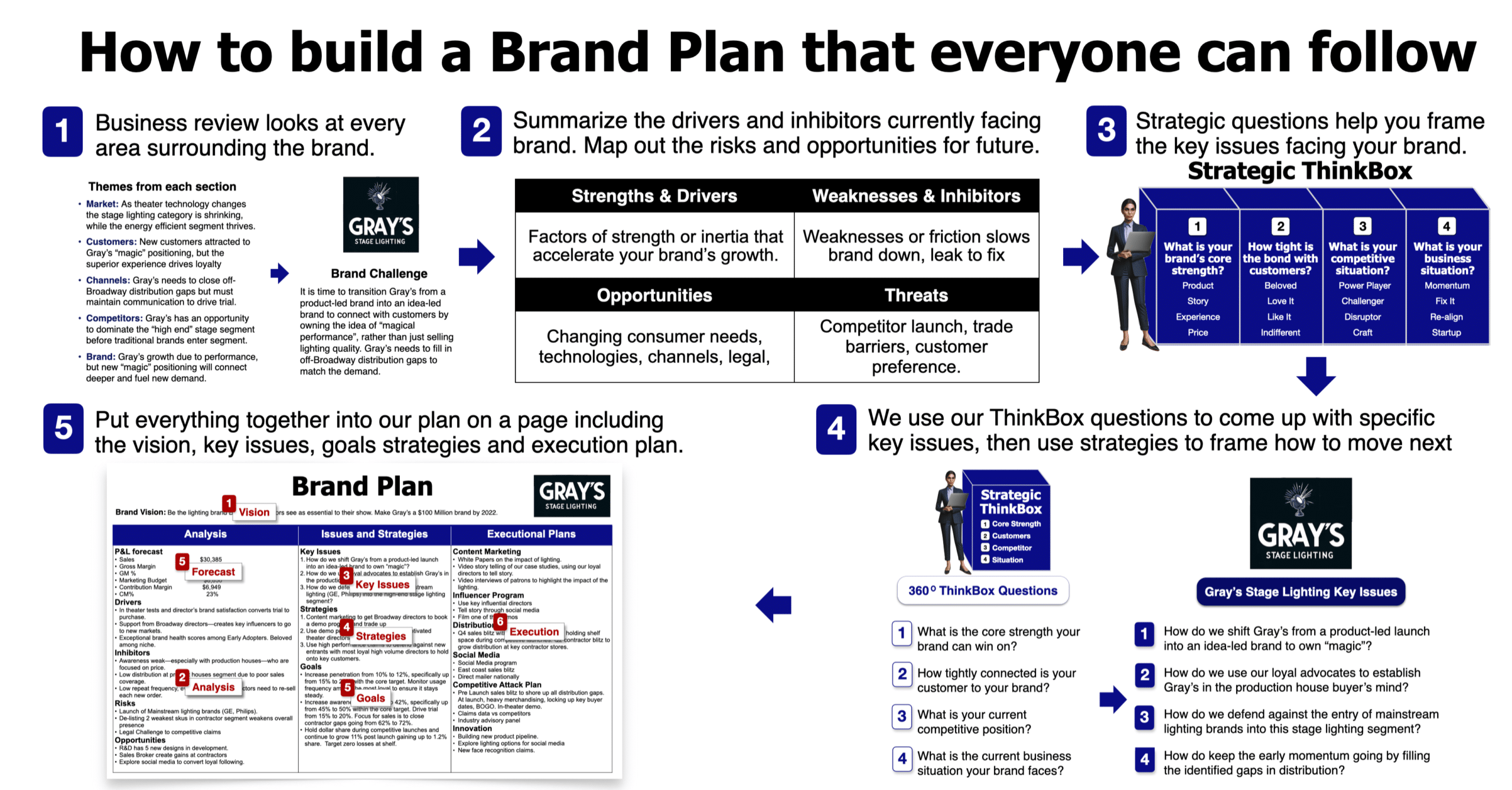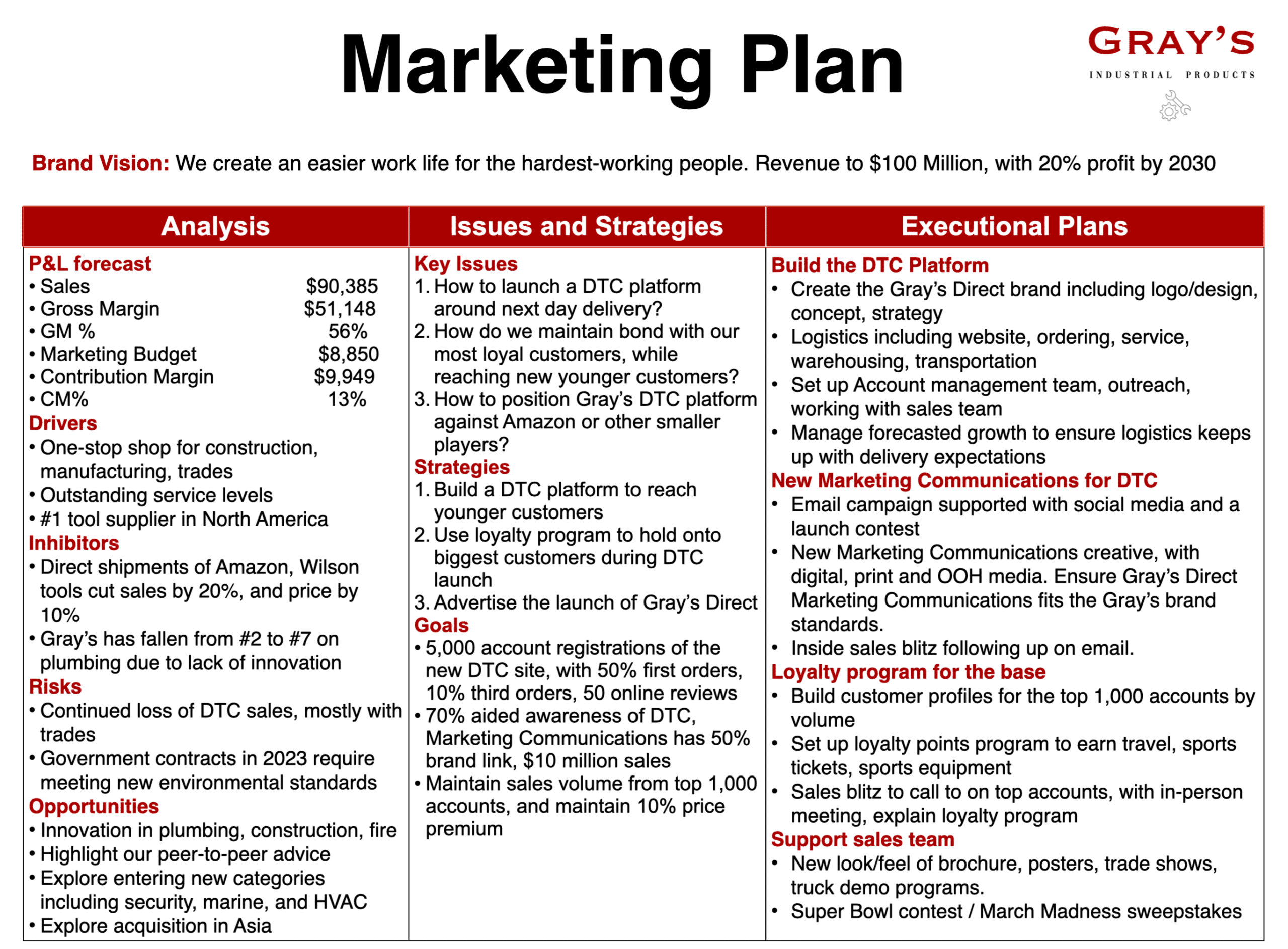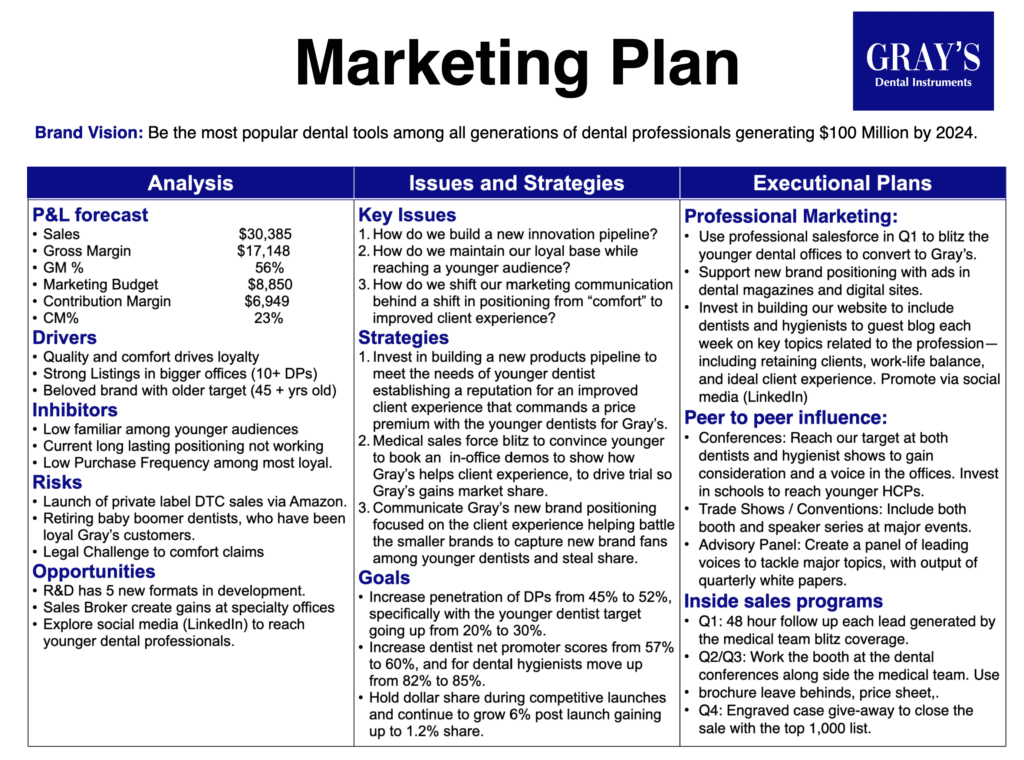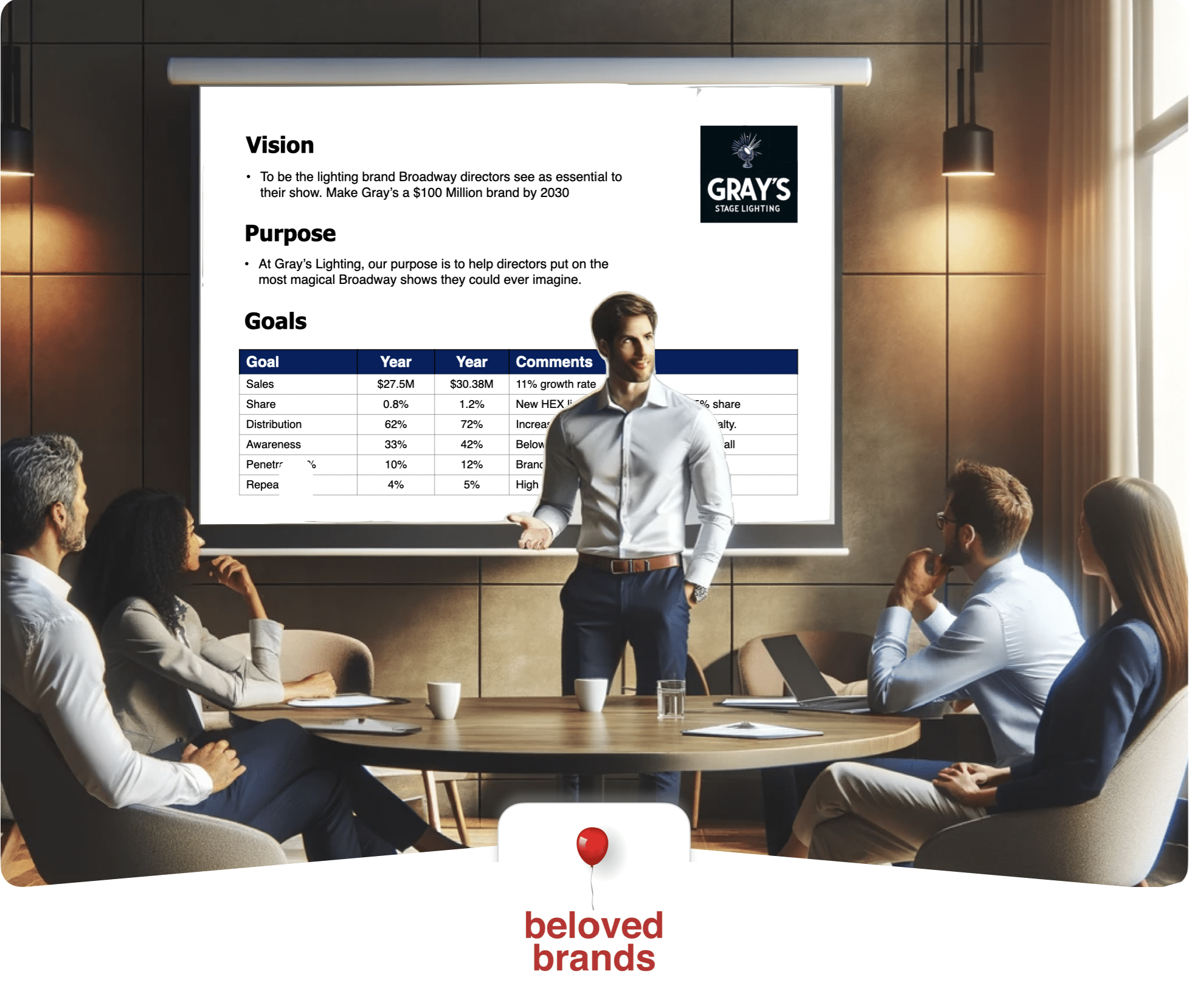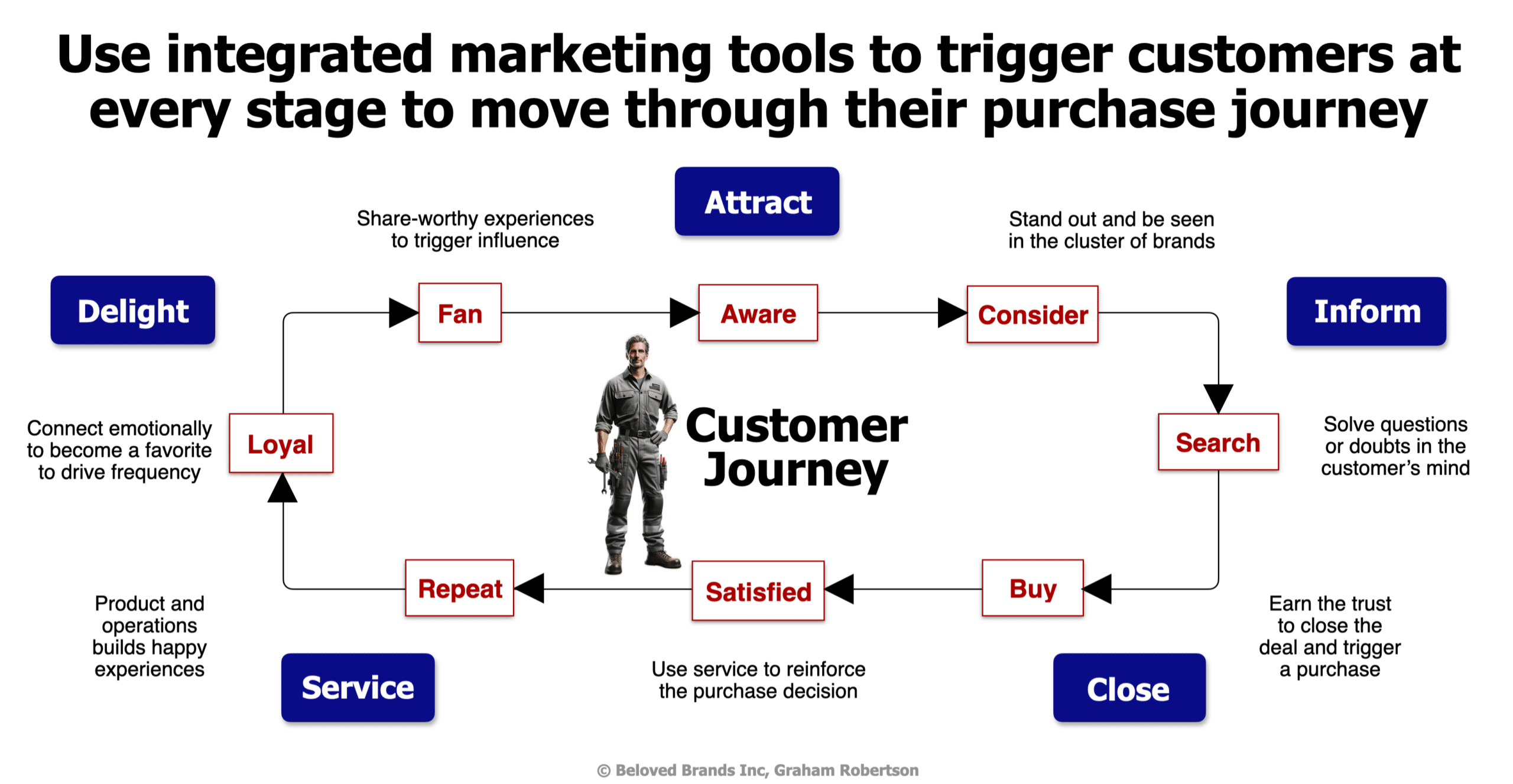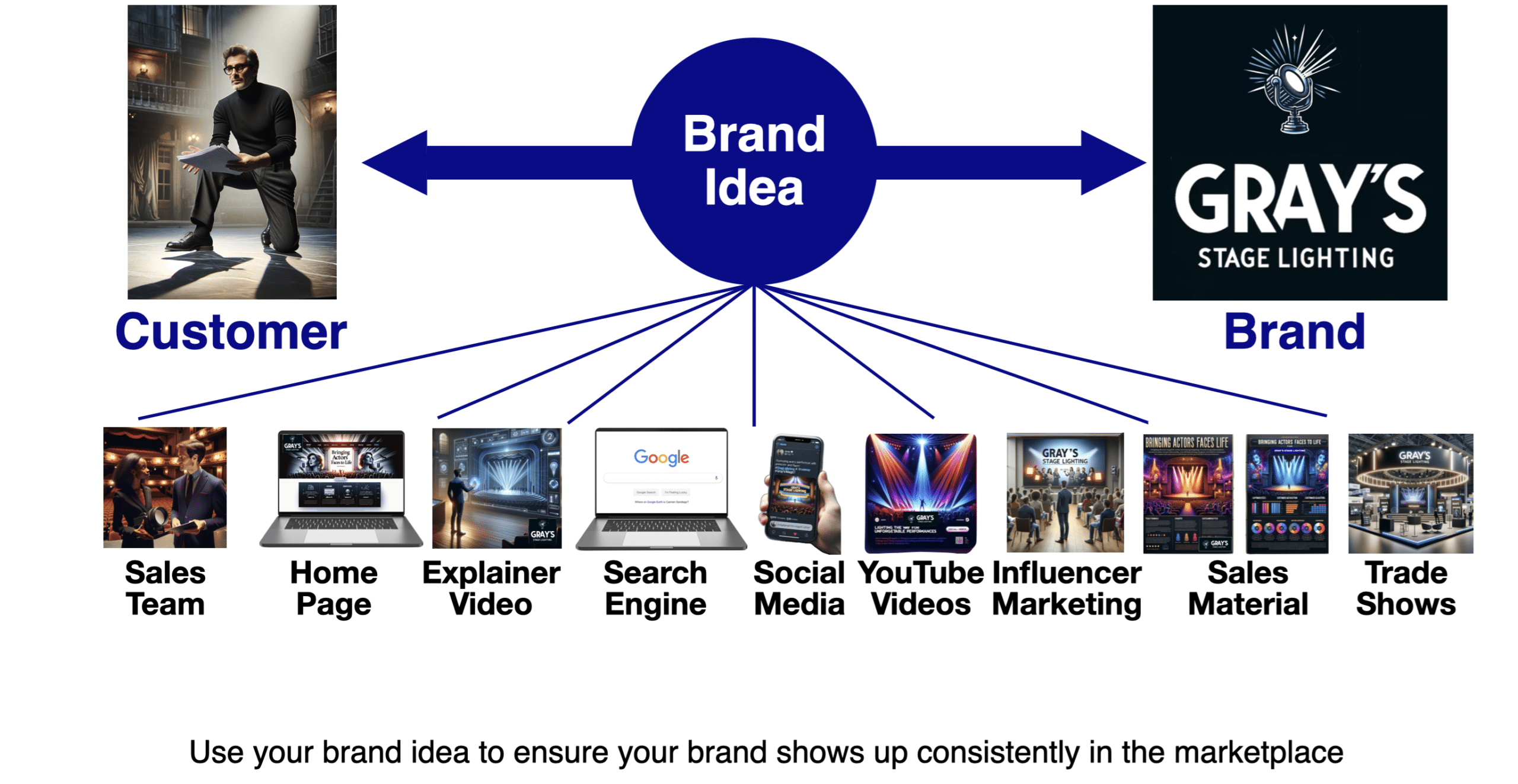B2B marketing can be more challenging than other types of businesses. Rarely do we think of one customer. Instead, we focus on four types of people within the B2B customers. Users. Decision-makers. Buyers. Influencers. Modern day B2B marketing allows you to figure out how to bypass the rules and restrictions of being a preferred vendors. For B2B marketers, we teach how to think strategically, how to use brand positioning, how to build a marketing plan, how to make marketing execution decisions, and how to analyze the brand.
Regardless, B2B marketers must use their brand positioning to establish a reputation and create a bond with customers. B2B decisions by customers are much more emotional, yet too many B2B companies focus on product features as the main differentiator and use price as their usual deal closer.
I bring a lot of experience with B2B marketing, having started my career working at GE Lighting where I worked on the commercial and industrial lighting business, and then the automotive lighting business. And, as a consultant, I have worked with many B2B brands, including industrial, medical equipment, OEMs, packaging, technology, and scientific discovery brands. Clients have included Slack, 3M, Shell, BD, Samsara, BASF, Briggs & Stratton, and Marrone Bio Innovations.
B2B Marketing - Table of Contents
Are you a B2B marketer?
Learn how to think, define, plan, execute, and analyze.
To define a B2B brand, I will provide a tool for writing a brand positioning statement, a customer profile, and a B2B professional profile. Then, we introduce our customer benefits ladder with lists of potential functional and emotional benefits to kickstart your thinking on brand positioning.
We explore the step-by-step process to develop your brand idea and bring it together with a tool for writing the ideal brand concept. We show the two-sided coin of a B2B brand concept, expressed to the B2B professional that includes users, decision-makers, buyers, and influencers.
Building the brand plan.
B2B marketers must know how to build their brand plans. I provide formats for a long-range brand strategy roadmap and the annual brand plan with definitions for each planning element. From there, I show how to build a brand execution plan that includes the creative brief, innovation process, and sales plan. I provide tools for creating a brand calendar and specific project plans.
To grow your brand, I show how to make smart decisions on execution around creative communications and media choices. I provide all the tools you need to write a deep-dive business review, looking at the marketplace, customer, channels, competitors, and the brand. Write everything so that it is easy to follow and implement for your brand.
You will learn everything you need to know to run your brand.
We have translated most of our brand tools into brand management templates in downloadable PowerPoint presentations that you can purchase at beloved-brands.com
My brand promise is to help make you smarter so you can realize your full potential in your career. The big difference with our B2B Marketing Training program is that every example I use will be a B2B brand.
To illustrate what B2B marketers must know, click to zoom in.
Brand templates for B2B brands
Our brand toolkit for B2B brands is our most comprehensive template helps you communicate your brand plans, brand positioning, business review and creative briefs.
Our brand plan template offers slides for vision, purpose, analysis, key issues, strategies, and execution plans, ensuring a thorough approach to your brand’s development. The brand positioning template guides you through defining your target profile, crafting a brand positioning statement, and developing a unique brand idea, concept, values, story, credo, and creative brief. Finally, our business review template provides slides for in-depth analysis of the marketplace, customers, competitors, channels, and your brand.
Choose the right template for your business needs
What is B2B marketing strategy?
Strategic thinkers see questions before they see solutions
Ever hear someone say, “That’s a good question?” It usually means someone has just asked an interruptive question, designed to slow everyone’s thinking, so they reflect and plan before acting.
The strategic thinking side of marketing is logical and has to map out a range of intersecting decision trees by imagining how events will play out in the future. There is a risk of being too strategic if you think too long, you may spiral around, unable to decide. Moreover, you may miss an opportunity window.
Everyone says they are strategic thinkers, yet few are. I confess that I was more of an instinctual marketer early in my career. B2B marketers need to slow down and organize our thoughts to learn strategic thinking. We look at five elements of strategic thinking, including the vision, strategic program, focused opportunity, market impact, and performance result.
To help B2B marketers, we have created a flywheel where the strategy keeps fueling more power and profit.
To illustrate how B2B marketers should think, click to zoom in.
Using Gray's QuitFix to demonstrate strategic thinking

Gray’s Stage Lighting is 3 years after launching, using a significant technology advancement to disruptive the smallest segment of the lighting category. The large mainstream competitors have yet to react. Gray’s needs to get broadway directors to allow a ‘see it to believe it’ demo, so sales can close the deal. They want to keep their early momentum going by fixing any distribution gaps.
Five elements of smart strategic thinking using our Gray’s Stage Lighting example:
1. Set a vision of what you want
- To be the stage lighting brand Broadway directors see as essential to their show with sales of $100 Million by 2030, by earning a reputation for creating magic, winning Tony Awards, and #1 lighting brand on Broadway.
2. Define Issues of what’s in the way
- How do we shift Gray’s from a product-led launch into an idea-led brand to own “magic”?How do we use our loyal advocates to establish Gray’s in the production house buyer’s mind? How do we defend against the entry of mainstream lighting brands into this stage lighting segment?
3. Invest resources in a strategic program
- At the rapid growth stage, Gray’s needs to build a strong bond with customers and address the distribution gaps while battling any mainstream brands who could enter the stage lighting segment.
4. Focus on an identified opportunity
- Gray’s recognizes the opportunity to shift Gray’s from a product-led launch into an idea-led brand to own “magic.” The brand’s content marketing strategy will include key influencers to speak on Gray’s behalf to boost customer interest and build brand trust.
5. Leverage a breakthrough market impact and performance result
- As Gray’s manages to get production houses to book a demo program, we know the demo trial will translate into purchases and successful theater implementation. Gray’s will gain market share that boosts volume, helping to lower the overall cost of its lighting products.
How to turn smart strategic thinking into strategic objective statements
Now, let’s look at turning your smart strategic thinking into writing a strategic statement that can provide specific marching orders to everyone who works on the brand. Writing strategy is an essential skill for B2B marketers to know.
The process covers all five elements of smart strategic thinking. You can see that the brand vision and key issue statement cover the first strategic element. However, you need the strategic objective statement to cover the remaining four other strategic elements, including the program investment, focused opportunity, market impact, and the performance result.
To illustrate brand strategy to help B2B marketers, click to zoom in.
Here’s how that B2B strategic statement breaks down:
P – Program investment:
- The strategy statement calls out the investment in a strategic program, with crystal clear marching orders to the team, leaving no room for doubt, confusion, or hesitation. In this example, the strategic program is: “Use Influencer Marketing with high-profile directors.”
A – Focused Accelerator:
- A breakthrough point where the brand will exert pressure to create a market impact. In this example, the focused opportunity is “to Broadway Directors looking for an advantage.”
P – Performance result:
- Drive a specific performance result linked to the market impact, making the brand more powerful or more profitable. In this example, “to inform them of Gray’s performance so they book a Demo that will help close the deal.”
Writing your brand strategy statements
This unique strategic model will force you to pick answers to build a strategy statement with marching orders for those who follow your plan. As you develop your brand plan, I recommend using these four elements of smart strategic objective statements to ensure you structure the thinking.
Below is how we teach writing strategy statements in our B2B Marketing Training program
The strategic program addresses what you are investing in and the target? And, focus provides a distinct opportunity to take advantage of. A market impact maps out the desired response as you move the customer along their journey. And, the performance result harnesses the power or profit.
To illustrate how B2B marketers must write strategy, click to zoom in.
Brand positioning process
How to define your brand positioning to set up your brand to win
If you do not define your brand, then you run the risk of the possibility that your competitors will define your brand. And you might not like it.
I will show you the homework you must do to figure out a winning B2B brand positioning statement. The tools are designed to help decide who your brand will serve and what you will stand for as a brand. Narrow the target to those customers who are most capable of loving what your brand does best.
I will show you how to find the ideal balance between the functional and emotional benefits, to find which ones are simple, interesting, motivating, and ownable for your brand.
Below, click to zoom in on our B2B brand positioning process.
To illustrate what B2B marketers must know, click to zoom in.
Brands have four choices: be better, different, cheaper, or else not around for long.
As you create your brand positioning statement, look for the ideal space to play and space your brand can win. Your brand might be fast, but if your competitor is even faster, then you will lose out if you try to play in that space.
Defining the ideal B2B target market
Most marketers think of the type of customers they want to attract. Why not change your thinking and go after those customers who are already motivated by what your brand offers? So instead of asking, “Who do we want?” you should be saying, “Who wants us?”
I use seven fundamental questions to define and build a profile of your ideal B2B customer target:
- Description of the ideal target?
- What are their main needs?
- Who is their enemy who torments them every day?
- What are the insights we know about the ideal target?
- What does they think now?
- How do they buy?
- What do we want them to see, think, do, feel or whisper?
Brand Positioning for B2B brands
Using the customer benefits ladder for B2B brands
Once the customer profile has been completed, brainstorm all possible brand features that give your brand a competitive advantage. Move up to the functional benefits by asking, “So, what do I get from that?” Then move up to the emotional benefits by asking, “So, how does that make me feel?”
To help brand leaders, I have created benefit cheatsheets with over 50 potential functional benefits and 40 potential emotional benefits. We show how to build your brand positioning around the right benefits. Then, add in the ideal reasons to believe that allow you to complete the brand positioning statement. Below is the brand positioning statement for Gray’s Stage Lighting.
To illustrate what B2B marketers must know, click to zoom in.
Video - B2B Brand Positioning
Our brand positioning statement video shows how to use our functional benefit cheatsheet and our emotional benefit cheatsheet to help build the ideal brand positioning statement for a B2B brand.
To view, use the ▶️ controls to play or volume buttons
To illustrate, click on any of the examples above.
Brand Positioning Template
Get the B2B brand positioning template designed by an ex-VP of Marketing who knows exactly what your boss wants to see.
- Expertly Guided Templates: Includes B2B customer profile, brand positioning, brand idea, brand concept, brand key model, and creative brief. Leverage B2B examples and definitions on each slide, enabling you to communicate your ideas and strategies precisely.
- Proven to Work: Unlike generic templates, ours are derived from years of experience and used by the best marketers to get their strategies approved.
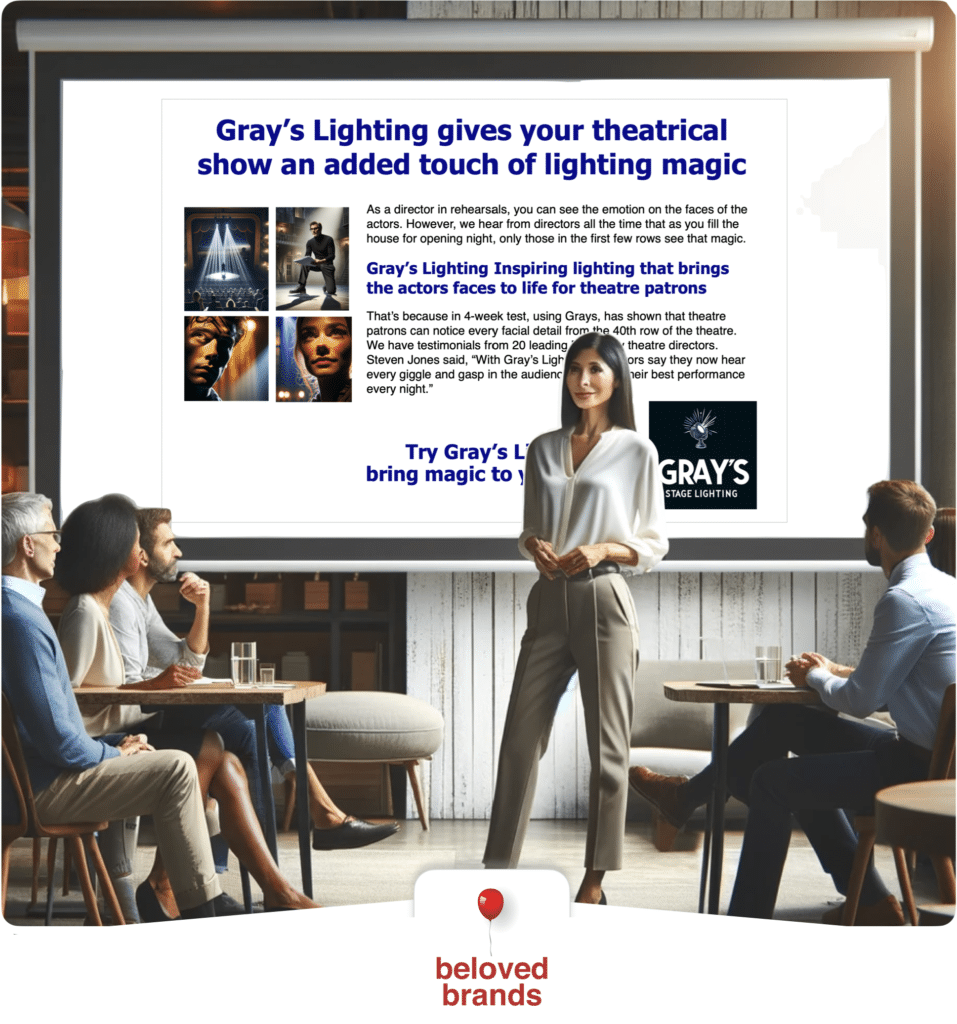
Building your brand idea
To me, the brand idea simplifies everything, not just for the customer, but for everyone working on the brand. The dictionary definition of the word “idea” means a thought, opinion, belief, or mental impression. A brand idea must be all those things. B2B marketers must know how to define their brand idea. Describe the products or services. What is the customer reputation? What about influencer reputation? Cultural inspiration? And, then figure out the brand idea.
To illustrate what B2B marketers must know, click to zoom in.
Brand idea checklist
For B2B brands, find a brand idea that is interesting enough to engage and entice customers on a first encounter to want to know more. Keep it simple enough to gain entry into the customer’s mind.
Your idea must be easily layered to organize everything you do to match up with the five customer touchpoints, including the brand promise, brand story, innovation, purchase moment, and customer experience.
Build a brand reputation
The idea must be unique enough to build a reputation so customers will perceive the brand as better, different, or cheaper. Your brand idea must be able to motivate customers to think, feel, and act in ways that benefit your brand. The idea must represent the inner brand soul of everyone who works on the brand, inspiring employees to deliver the brand promise and amazing experiences.
Finally, the brand idea must be ownable so no other competitor can infringe on your space, and you can confidently build your brand reputation over time.
Brand Idea B2B Industrial OEM
Brand Idea - B2B medical equipment
To illustrate, click on any of the examples above.
Turn your positioning work into a brand conceptyou can validate with customers
Building a Brand Plan for a B2B brand
B2B marketers must look at the plan as a decision-making tool that guides everyone who works on the brand. We teach how to come up with the brand vision, purpose, goals, key issues, strategies and marketing execution plans. If you are a B2B marketer, you need to know how to build a plan.
To illustrate the B2B brand plan process, click to zoom in.
As you write the annual brand plan, use the vision to steer the decisions. Then lay out the key issues and strategies as the guts of the plan. Lay out in a one pager. Or, use our B2B Brand template presentation.
Analysis:
The analysis section lays out the summary from the deep-dive business review with an overview of the top three points, which envelop what is driving your brand’s growth, what is inhibiting your brand’s growth, which threats could hurt your brand and what opportunities your brand faces.
Key issues and strategies:
The key issues and strategies section focuses on the top three issues getting in the way of achieving your vision, which you should put in question format. Moreover, the strategic solutions are the answers that match up to each of those questions. Set goals to measure your brand’s performance against each strategy.
Execution section:
The execution section maps out the specific plans for each of the chosen execution areas that aligns with the most essential customer touchpoints.
To illustrate how to do a B2B brand plan, click to zoom in.
I first came up with this “brand plan-on a page” format when I led a team with 15 brands. It helped me see the big picture quickly, rather than having to hunt through a big thick binder. Also, the sales team appreciated the ability to see the entire plan on one page quickly. Most salespeople also had 15 brands to manage with each of their customers. Everyone who works on your brand should receive the one-page plan and keep it close by to steer their day-to-day decisions.
B2B Brand Plan examples
To illustrate, click on any of the examples above.
B2B Brand Plan template
Get the B2B brand plan designed by an ex-VP of Marketing who knows exactly what your boss wants to see.
- Follow the best: Expertly designed based on how the world’s best marketers present their B2B brand plans.
- Expertly Guided Templates: Leverage B2B examples and definitions on each slide, enabling you to communicate ideas and strategies with precision.
- Proven to Work: Unlike generic templates, ours are derived from years of experience and used by the best marketers to get their strategies approved.
B2B marketing on social media
Manage your customers through their purchase journey
While we talk a lot about customer-based social media options, we are seeing bigger opportunities for B2B brands, whether you focused on the user, decision-maker, buyer, or influencer. It allows us to find prospects and move them through their journey. We look at attract, inform, close, service and delight.
Attract and inform
To drive awareness, you need your marketing communications to stand out and be seen in a crowd using messaging that balances being creatively different and strategically smart. When your messages are smart but not different, they get lost in the clutter. On the other hand, when your messages are different but not smart, they will entertain customers, but do nothing for your brand. Your communications must be smart enough to trigger the desired customer response to match your brand strategy.
To move B2B customers to the consideration stage, use influencers to teach those who seek to learn more. Use public relations to make the brand part of the industry news, whether through traditional, social, or blogger channels. Engage online user reviews or industry-specific review sites.
For more complex or higher risk purchase decisions, many B2B customers will rely on search for almost everything, even if to confirm what makes sense. B2B marketers can use search sites, such as Google, expert review sites, and online content or long copy print media.
Over the last decade, I see a shift where B2B customers prefer to take the time to do their own research rather than a face-to-face call from a sales rep. The brand website comes into play and should include the right information to close off gaps or doubts, then move customers towards the purchase decision.
Servicing through account based marketing
Account-based marketing (ABM) can be used to move customers along their purchase journey to help trigger an initial purchase with displays, trial programs, or sales materials to prompt customers. Remarketing is a great tool to push customers who might feel stuck at the consideration stage to reconsider and buy.
After the purchase, use the account-based marketing to turn usage into an early purchase into a ritual among your most loyal users. Cultivate a collection of brand fans, using VIP programs and experiential events with exclusive deals — layer in emotional marketing communications to tighten the bond.
Delighting those who love the brand
Once you have a strong base, you can mobilize your brand lovers by intentionally creating shareable experiences, which will trigger brand lovers to share your brand communications with their network through social media. With the new social media tools, the smartest brands are getting their most engaged customers to drive awareness by sharing your message – and even enthusiastic user-generated content.
For B2B brands, always keep in mind the four-headed monster we talked about in the customer session, with the user, decision maker, buyer, and influencers. As you shift to engaging individuals, recognize the role each plays, and then match up your marketing communication to their specific needs.
Using the brand idea to steer the media choices
B2B Marketing Training
Our B2B marketing training will make your marketing team smarter so they deliver their best possible performance on your brand. At Beloved Brands, we empower the ambitious B2B marketers to achieve the extraordinary. Below is our brochure for our training programs.
Below is our brochure that explains how our B2B marketing training can help your team
Engage the buttons to enlarge (X) or advance the slides (>).
How our B2B Marketing Training makes your team smarter
Strategic Thinking:
Our B2B marketing training teaches brand leaders how to ask tough strategic questions to slow everyone down. B2B marketers need to approach strategy in a thoughtful, analytical way. We created a Strategic ThinkBox that allows marketers to interrogate their brand. Most importantly, it helps them look at the most important issues of the business. Furthermore, we force marketers to take a holistic look at their brand’s core strength, competitive landscape, tightness of the customer bond, and business situation.
Brand Positioning:
Our brand positioning process starts by finding out the ideal target is and how they would benefit from the brand. For B2B brands, the target could be a user, buyer, influencer, or a decision-maker. We teach marketers how to find the emotional and functional benefits their brand can deliver. Then, we show how to find a unique space for their brand that is interesting, simple, motivating, and ownable. Furthermore, we introduce our brand idea tool and show how to communicate that brand idea across the organization. In addition, B2B marketers learn how to write a brand concept, brand story, and a brand credo document. We show a range of B2B brand examples.
Marketing Plans:
The marketing plan is a decision-making tool that communicates the expectations to everyone who works on the brand. We teach B2B marketers how to put together the vision, purpose, goals, key issues, strategies and marketing execution plans. Our B2B marketing training provides various tools including our one-page marketing plan and ideal presentation deck. Most importantly, we go into detail on how to write key issue questions and strategic statements that forms the foundation of the marketing plan.
Marketing Execution:
Our marketing execution training starts with the development of the creative brief, which serves as the bridge between the plan and execution. We review line-by-line of the creative brief and give you examples of the best and worst. Furthermore, we even provide participants with a checklist to make smarter decisions on your next marketing campaign. We introduce our creative checklist to help make smarter decisions on creative communications. All our examples are B2B brands. And, we emphasize how to match up media choices to the customer journey. Essentially, the skills will help your team get better work from their agency partners.
Brand Analytics:
Our comprehensive brand analytics sessions teach B2B marketers how to lead a deep-dive business review. They need to know how to assess their brand’s performance, and set up smarter strategic thinking for their marketing plan. As a result, we get B2B marketers to look at the marketplace, customers, channels of distribution, competitors or other brands in their industry category. Finally, we show how to lead an audit on the performance indicators of the brand.
All our examples are B2B brands
With our B2B marketing training, every example we use in our training is a B2B brand. We believe B2B marketers will learn the concepts if they see brands that are similar to the ones they are working on.
Contact us
Looking for more information on our B2B Training programs? Contact Graham Robertson at graham@beloved-brands.com



